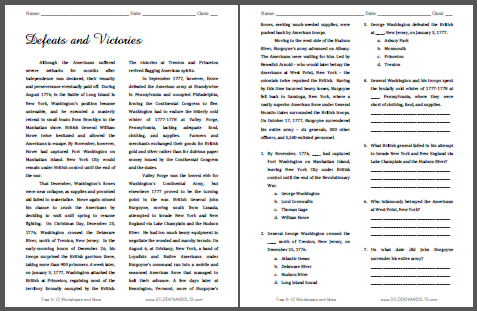| Defeats and Victories Reading with Questions |
|---|
| www.studenthandouts.com ↣ American History ↣ American History Readings |
 Although the Americans suffered severe setbacks for months after independence was declared, their tenacity and perseverance eventually paid off. During August 1776, in the Battle of Long Island in New York, Washington's position became untenable, and he executed a masterly retreat in small boats from Brooklyn to the Manhattan shore. British General William Howe twice hesitated and allowed the Americans to escape. By November, however, Howe had captured Fort Washington on Manhattan Island. New York City would remain under British control until the end of the war.
Although the Americans suffered severe setbacks for months after independence was declared, their tenacity and perseverance eventually paid off. During August 1776, in the Battle of Long Island in New York, Washington's position became untenable, and he executed a masterly retreat in small boats from Brooklyn to the Manhattan shore. British General William Howe twice hesitated and allowed the Americans to escape. By November, however, Howe had captured Fort Washington on Manhattan Island. New York City would remain under British control until the end of the war.That December, Washington's forces were near collapse, as supplies and promised aid failed to materialize. Howe again missed his chance to crush the Americans by deciding to wait until spring to resume fighting. On Christmas Day, December 25, 1776, Washington crossed the Delaware River, north of Trenton, New Jersey. In the early-morning hours of December 26, his troops surprised the British garrison there, taking more than 900 prisoners. A week later, on January 3, 1777, Washington attacked the British at Princeton, regaining most of the territory formally occupied by the British. The victories at Trenton and Princeton revived flagging American spirits. In September 1777, however, Howe defeated the American army at Brandywine in Pennsylvania and occupied Philadelphia, forcing the Continental Congress to flee. Washington had to endure the bitterly cold winter of 1777‑1778 at Valley Forge, Pennsylvania, lacking adequate food, clothing, and supplies. Farmers and merchants exchanged their goods for British gold and silver rather than for dubious paper money issued by the Continental Congress and the states. Valley Forge was the lowest ebb for Washington's Continental Army, but elsewhere 1777 proved to be the turning point in the war. British General John Burgoyne, moving south from Canada, attempted to invade New York and New England via Lake Champlain and the Hudson River. He had too much heavy equipment to negotiate the wooded and marshy terrain. On August 6, at Oriskany, New York, a band of Loyalists and Native Americans under Burgoyne's command ran into a mobile and seasoned American force that managed to halt their advance. A few days later at Bennington, Vermont, more of Burgoyne's forces, seeking much-needed supplies, were pushed back by American troops. Moving to the west side of the Hudson River, Burgoyne's army advanced on Albany. The Americans were waiting for him. Led by Benedict Arnold—who would later betray the Americans at West Point, New York—the colonials twice repulsed the British. Having by this time incurred heavy losses, Burgoyne fell back to Saratoga, New York, where a vastly superior American force under General Horatio Gates surrounded the British troops. On October 17, 1777, Burgoyne surrendered his entire army—six generals, 300 other officers, and 5,500 enlisted personnel. Click here to print. Answer Key: (1) D - William Howe, (2) B - Delaware River, (3) C - Princeton, (4) Valley Forge, (5) John Burgoyne, (6) Benedict Arnold, (7) October 17, 1777. |
 |  |  |  |  |  |
| www.studenthandouts.com ↣ American History ↣ American History Readings |








